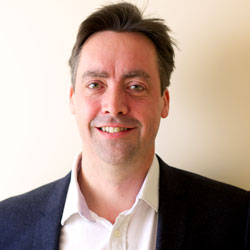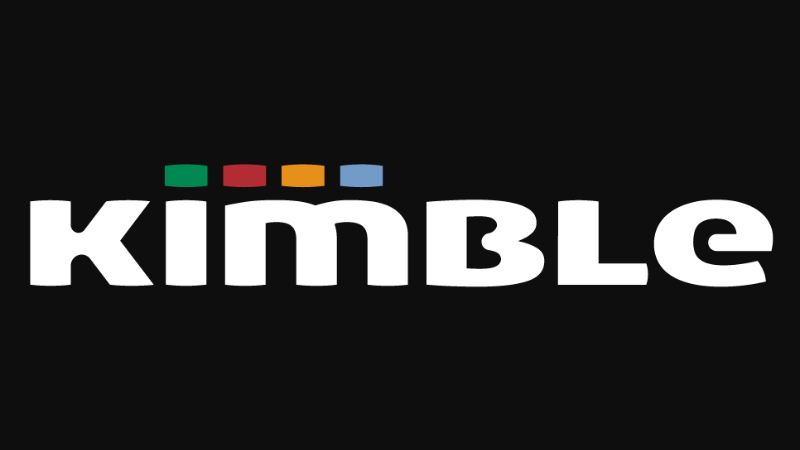
Sean Hoban is a co-founder and the CEO of Kimble. He has worked in the IT Consultancy sector for over 25 years. In that time he has worked at Oracle and LogicaCMG as well as start-up consultancies and software firms. Prior to co-founding Kimble he was a Director at Edenbrook before its acquisition by Hitachi Consulting.
Kimble is a professional services automation solution built on the Salesforce platform. The company describes itself as having a holistic focus on business improvement, beyond just operational support or project delivery. It believes that this is unique in the professional services automation (PSA) market. We caught up with Hoban at Dreamforce
ET: Who is your inspiration and why?
Hoban: There are different inspirations. From a business perspective I read a book a while ago by Ben Horowitz, The Hard Thing About Hard Things. It was inspirational in the fact that it is just bloody tough. Knowing it’s tough, that you’ve just got to keep ploughing through and knocking down the various barriers that come up, was for me: ‘okay I know it’s hard but actually having someone else tell me it’s hard was (inspiring).’
In terms of technology, it’s very clichéd but I love Elon Musk. I love the fact that Elon challenged the norm. What he’s done with Tesla is superb. It’s an inspiration in terms of how quickly he’s turned Tesla into what could be a very serious global car manufacturer and against the backdrop of petrol addicts in the US. The amount of Tesla’s you see in San Francisco is fantastic.
ET: How do you describe your leadership style?
Hoban: Rolling my sleeves up and doing it with other people. Apart from developing the code, I have done pretty much every job in the company. I think it’s important that you know what’s involved in each job so when you scale and you’re big enough to hire people in, you actually understand what they’re trying to achieve.
You can guide them better by knowing what the real problems are that they are trying to solve. They’ve got respect for you because you can help them solve problems. What you’re doing is coaching them in how to think about what their problems are. It’s very hands on, partly out of necessity, definitely not ivory towers.
ET: What’s on the radar in terms of future tech for Kimble?
Hoban: Over the last 18 months we’ve been moving the product towards predictive analytics. This isn’t because of Einstein. I don’t call it AI because it’s not AI, but it’s starting to become one. Think about Malcolm Gladwell’s – 10,000 Hours to be Good at Anything and look at project managers. The biggest challenge for professional services is managing that engagement or project, getting the profitability in there and obviously maximising the resources. Most project managers haven’t had 10,000 hours of experience of knowing what to do in terms of project management.
What we’ve started to bake into the product is this augmented intelligence. We’re starting to guide the project managers to the things that they should do. We’ve already baked that into the system with charms, which are advanced warnings for project manager rather like a petrol warning light on cars.
Clicking on the charm guides them to what they need to do. Do I need to get some more purchase order cover? Do I need to extend some person on an assignment? I haven’t done a status report – I need to put in a status report – that sort of thing. So we’ve got a bunch of charms that surface when certain data conditions are met. The next evolution for us is doing that at a company level. Looking at a professional service organisation and saying: ‘okay what trends are we seeing. Are we seeing your overall gross margin decline? Why is that?’ We then have to guide them to what the problem is.
ET: In every segment and project?
Hoban:“Exactly. So you might have one fixed price project where you’ve suddenly had to chuck a load of extra effort on. It’s reduced your gross margin on what is maybe a significant project. That’s hit your business but it’s just on one project. But maybe you’ve started to see a decline in day rates across all of your projects. In that case you’ve got a rate problem here.
That’s where we’re starting to have that intelligence in the system to guide the business owners, not just the project managers, in what they need to do to correct it. You’d be really surprised at how bad some of the business owners are in understanding what the KPI is really telling them.
ET: So are your coders not developing an AI? In theory it could analyse the data, spot the trends and then say these are the problems behind that trend without actually having the code to determine that?
Hoban: Yes it’s coded but it’s looking at trends. I don’t think our data set will ever be large enough. Maybe if we aggregate it across all of our customers we may be able to get some [free] learning then across a super set of data. On an individual customer I am not convinced the volume of data will ever be sufficient to really learn. From a technology perspective that’s a real big push for us, it’s been on our road map for years and we’re just chipping away at that.
ET: What are the key challenges currently faced by your industry?
Hoban: Look at the industry of professional services, as opposed to software development. We see that they’ve been under margin pressure, and this is why I think PSA as a segment is becoming more popular. It really goes back to the Indian off-shore company starting to do it.
What you’re also seeing is that millennials are changing their work patterns so that the employee to contractor mix is changing. It means more of your workforce is a contract workforce and your margin is under pressure because you’re having to use contractors rather than employees.
You are also seeing the staffing companies starting to move into becoming consulting firms as well. It’s becoming a bigger market and getting more and more competitive for consulting firms. Most of our customers, or people coming to us, are green field. They don’t already have a PSA that they’re replacing. We see pressure on margins driving efficiency.
Finding the right resources to work on your project is a global challenge now, even for the big boys. They need clever resourcing systems to find the right people. It might be someone in their existing workforce or a contractor. For example, a Blockchain expert who speaks French with financial services industry experience. Finding those people is a challenge for them.
ET: What’s the best question you’ve been asked at Dreamforce ?
Hoban: Why do you partner with Sage? I answer that by saying the Salesforce platform really helps this as we’ve got very tight integration with Sage Live. We’re building integration with X3 as well. We were the first partner to integrate with Sage Live which was partly driven by necessity for us. If you look at what we do, we understand professional services and we’ve built a domain solution in that space.
What we don’t do is CRM so we integrate with Sales Cloud for that. We don’t do finance so we integrate with lots of different finance systems. We integrate with HR systems as well. So our message to the market and to our customers is it’s best of breed. The best of breed argument 10 years ago didn’t hold water because the integration costs were so big.
Now if you’re talking about a Salesforce platform, the integration costs aren’t big and we’ve got pre-built in integration with Sage Live. You haven’t got that heavy lift of integration. What that allows the customer to do is go: “I want this HR solution because I want the best HR solution that meets my business needs. I’ve got the best PSA, I’ve got the right finance system”. Everyone talked about the best of breed 10/20 years ago but it never really happened. Instead the suites came in but they have, I would say, sub-standard modules within them. The problem is you have to take all the modules, you don’t get a choice.
ET: What are your personal challenges over the next 12 months?
Hoban:“Scaling in the USA. We’ve been building our operations in the US now for 3 years. We’ve looked at getting that base-level of efficiency across all areas of the business and now we’ve got that.
ET: That’s the business challenges for the next 12 months, have you got personal challenges?
Hoban: Once a year we have a man-challenge weekend. It’s something you put in your diary to look forward to. I’ve got a house down in the South of France, so we’re going to cycle from the Atlantic down to the Med. We’re trying to pretty much follow the Canal du Midi, because it’s flat. It’s nice weather, nice food, nice wine and a bit of cycling. But it’s nothing like… I’m not scaling Everest or anything to that extent.
(For those interested the Canal du Midi is 241km long)
ET: What was your darkest business day, and how did you overcome it?
Hoban: At Edenbrook we had a very large account and a project that represented over 30% of the business. We had some quite hairy times because the client knew how significant that contract was to us. There was a bit of brinkmanship in terms of negotiating the next phase of that project which I think probably put a few grey hairs on me.
ET: How did you overcome it?
Hoban: Diplomacy and a bit of hard-balling really. I think the key is knowing when to stand firm. You can’t just keep giving. You’ve got to hold your line at some point and it’s knowing that. Judging that righ,t was the way to overcome it.
ET: And making sure that it’s not that far away from their line?
Hoban: Yes. It’s tramlines isn’t it. As long as you are in between the two tramlines neither side is taking the p*ss. That’s the challenge, making sure you’re always within the tramlines.
ET: What was your proudest moment?
Hoban: The problem with most jobs and most businesses is you forget to celebrate the successes. You’re constantly just looking at the next challenge or the next milestone in your business plan or your project, or whatever. Last year we just stopped and went: “actually we’ve built this great product, this great business, and we’ve got a really good team.”
I don’t think it was one moment, it was just a realisation of what you’ve achieved. It’s just stepping back every now and again and going look everything’s hard all the time but actually when you stop and look at what you’ve achieved it’s surprising. We’ve got coming up for 30,000 users on our solution and that’s the size of a small town.
ET: Can you share any tips for any new CEOs?
Hoban: Read, ‘The Hard Thing About Hard Things’ by Ben Horowitz. For new CEOs you’ve got to know going in with your eyes wide open that it’s going to be hard. There’s going to be really hard times but you’ve just got to remain focused. Focus is the number one thing.
ET: I wonder if you had any tips for start-up CEO’s trying to raise funds, or looking to raise funds?
Hoban: Yes. What we did, I think it was brilliant and this is hats off to the UK government from maybe 15 years ago, we did an angel round using the EIS scheme. It means it’s quite low risk for angel investors to put money in because they get money back straight away. They get about 30% now so if they invest £10,000 they’re really only investing £7,000. They are also going to get zero capital gains tax when it comes out. If there is any issue with that they can offset that loss easily as well. It’s a very low risk way for angel investors.
What the government needs to do now is bridge the gap. At the start-up angel seed round you can raise money pretty quickly, the issue is that when you scale up.
ET: How do you prioritise your day to day work against the strategic stuff?
Hoban: The majority is operational. You have to step back every now and again and look at the strategy. Operationally. day to day, you’ve just got to make sure you align with that strategy. Mark, myself and Dave, we are the three founders. We are in the business all day, every day, operating the business. We’re almost too close to it but what we do is lift our heads up every now and again. My job, really, is just to hoik people if I see them going slightly off-track. But I would say 95% of that time is day to day operational stuff and 5% is strategy. Once you’ve got a clear view of what your strategy is you don’t have to keep thinking it through.
ET: How do you keep believing in your vision when odds are stacked against you?
Hoban:“You just have to have tenacity. I can’t remember who it was, it was one of the PeopleSoft and now Workday founders. He’s got a mantra and a message in the workplace that you never diss the product. You have to have ultimate confidence that you’ve got a really good product and get everybody believing that within the company. Then it’s a self-fulfilling prophecy.
ET: How do you approach the challenge of rapid growth while maintaining culture?
Hoban: That is a challenge. I think it’s about your hiring and getting the cultural fit when you are hiring. We’ve got a good culture and the culture’s spread across a lot of people. When they are hiring now they’re hiring to the same culture.
ET: How do you see the company changing in the next 2 years and how do you see yourself helping to create that change?
Hoban: Well the change will really be a scale thing. We need to do more of the same, be more efficient about how we do it. Carry on what we’re doing but do it at a faster rate. It just comes back to culture. We’ve got to drive that constant innovation into the people and that will / should be a self-fulfilling prophecy.
ET: What’s the one question you would like to ask another CEO?
Hoban: I would ask them how they think they can really drive the company at a fast tempo of growth without working 60 / 70 hours a week? What’s the magic source to really getting that growth but without having to “bust your balls”? I don’t see many CEOs who can do that.
ET: So I will reflect that question back to you. How do you scale without burning yourself out?
Hoban: Team. A really good team, learning to delegate and learning to trust people. When you’re going from start-up it doesn’t take much to break a business really. We’ve been pretty capital efficient so we’re not doing it with huge funds and I am really pleased we didn’t. We could have taken a lot more money, but I think we would have been less efficient. It might have been easier, but I think ultimately to have a really efficient business that can scale, doing it with minimal capital is the right way to get the ultimate results.










